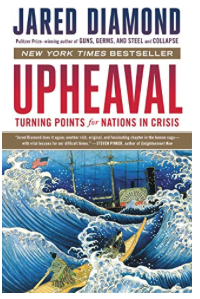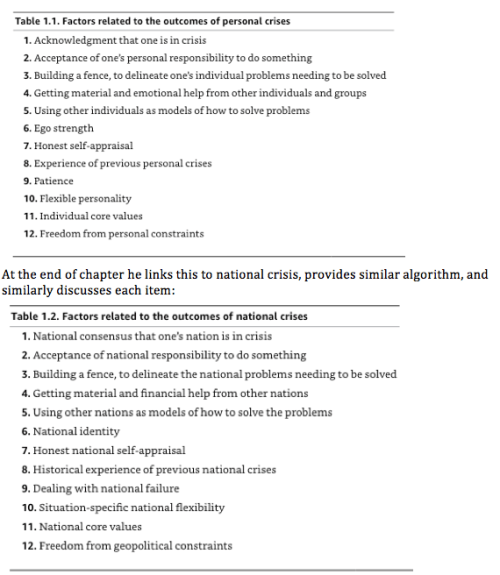
MAIN IDEA:
The main idea of this book is that a crisis that occurs in lives of individuals and history of countries is an important and difficult process with unpredictable outcome. The response to such crisis requires mobilization of all individual and societal strength and abilities to overcome successfully. From detailed analysis of history of countries in crises author is trying to derive some rules how to handle crises successfully and then suggests ways to deal with what he considered current and/or potential crises in USA and the World.
DETAILS:
Prologue: Legacies of Cocoanut Grove
Two stories—What’s a crisis? – Individual and national crises—What this book is and isn’t— Plan of the book
Here author refer to tragic fire in dancing hall in 1942 Boston that killed some 492 people. This tragedy caused multiple people, either survivors or relatives of victims to undergo difficult psychological crisis, which not all of them were capable to overcome. Here is how author defines crisis: ”one can think of a crisis as a moment of truth: a turning point, when conditions before and after that “moment” are “much more” different from one another than before and after “most” other moments.” After that author expands this notion of crisis from individuals to societies, providing as example history of Rome: ”a historian of ancient Rome might apply the word “crisis” to only three events after the foundation of the Roman Republic around 509 BC: the first two wars against Carthage (264–241 and 218–201 BC), the replacement of republican government by the empire (around 23 BC), and the barbarian invasions leading to the Western Roman Empire’s fall (around AD 476).” At the end of prologue author presents plan of the book, which is mainly discussion of historical crisis in several countries and look at the future for USA and the World.
PART 1 INDIVIDUALS
Chapter 1. Personal Crises
A personal crisis—Trajectories—Dealing with crises—Factors related to outcomes—National crises
Author begins this chapter with personal crisis story that he successfully overcame with the help of his father. Then he provides kind of algorithm of how to deal with crisis and discusses each item in his list:

PART 2.NATIONS: CRISES THAT UNFOLDED
In this part author reviews history of several countries where severe crises occurred and then connects these histories to factors that he provided in the table.
Chapter 2. Finland’s War with the Soviet Union
Visiting Finland—Language—Finland until 1939—The Winter War—The Winter War’s end – The Continuation War—After 1945—Walking a tightrope – Finlandization—Crisis framework Chapter
Here author retells the story of Russo-Finland winter war of 1940 and its continuation until 1945. Finland lost this war but not until it inflicted severe casualties on the USSR and caused serious ideological and psychological damage, eventually resulting in Stalin’s decision to tolerate its limited independence. Author makes point here that overcoming crisis took difficult steps of accepting Soviet humiliating demands and learning not to irritate this powerful neighbor.
- The Origins of Modern Japan
My Japanese connections—Japan before 1853—Perry—1853 to 1868—The Meiji Era—Meiji – Reforms—“Westernization”—Overseas expansion—Crisis framework—Questions
Here author reviews another crisis, this time from XIX century when Japan discovered that its traditional isolation stop working because Western military become so superior that it allowed force imposition of trade rules. Japan leadership successfully resolved this crisis by dramatically changing their behavior not only opening country, but also actively searching acquisition of knowledge and skills that consequently led to liquidation of military and industrial deficiencies, so within some 50 years Japan was able to win war against Russia in 1904.
Chapter 4. A Chile for All Chileans
Visiting Chile—Chile until 1970—Allende—The coup and Pinochet—Economics until “No! ‘— After Pinochet—Pinochet’s shadow—Crisis framework—Returning to Chile
This is review of another crisis, this time internal crises in Chile when socialist Allende, after being democratically elected, start moving to communist totalitarian regime. Chile’s society resisted, leading eventually to military coup. Author manages to maintain reasonably fair narrative retelling not only negatives, but also positive economic development that brought in relative prosperity to Chile after market reforms.
Chapter S. Indonesia, the Rise of a New Country
In a hotel—Indonesia’s background—The colonial era—Independence—Sukarno—Coup—Mass legacies—Crisis framework—Returning to Indonesia
This chapter is about another crisis, somewhat similar to Chile when leftist coup was stopped by military and consequential massacre of everybody even remotely on the left. This time the dictatorship was not able to move effectively to market economy and suppress corruption, so no happy ending occurred at the time. However author describes how he visited this country recently and found a lot less corruption and working economy.
Chapter 6. Rebuilding Germany
Germany in 1945—1945 to 1961—Germans holding judgment—1968—1 968’’s aftermath— Brandt and re-unification—Geographic constraints—Self-pity?-Leaders and realism—Crisis framework
This chapter about Germany concentrates on several crisis in this country and its post WWII history from division of the country to rise of Berlin wall to the fall of this wall. For some reason author pays lots of attention to students riot in 1968, but his main stress is on the change of this country from aggressive and highly militaristic to quite pacifistic.
Chapter 7. Australia: Who Are We?
Visiting Australia—First Fleet and Aborigines—Early immigrants
—Federation—Keeping them out—World War One—World War Two—Loosening the ties—The end of White Australia—Crisis framework
The final chapter of this part is about Australia, which did not have such tragic and bloody crises with wars or coups, just slow moving identity crises. This was pretty much recognition that Australia is not part of Britain any more and old mother country does not have neither resources nor will to provide protection and support. It was a slow process on both sides, but eventually Australia moved to practically complete independence, even if it still recognizes queen as formal head of the state.
PART 3 | NATIONS AND THE WORLD: CRISES UNDERWAY
In this part author moves to more consequential countries: Japan and USA and changes focus from looking back at historical crises to looking at ongoing crisis in these two countries, and what he believes could lie in the future not only for these two countries, but for the whole world.
Chapter 8. What Lies Ahead for Japan?
Japan today—Economy—Advantages—Government debt—Women—Babies—Old and declining—Immigration—China and Korea—Natural resource management—Crisis framework
This chapter is about what author believes is Japan crisis. The reasons are aging and decrease of population, debt, and not complete reconciliation with Korea and China after the war. He then moves through his list of crisis factors and checks pluses and minuses of Japan situation and crises handling.
Chapter 9. What Lies Ahead for the United States? Strengths, and the Biggest Problem The U.S. today—Wealth—Geography—Advantages of democracy—Other advantages—Political polarization—Why? —Other polarization
Chapter 10. What Lies Ahead for the United States? Three “Other” Problems
Other problems—Elections—Inequality and immobility—So what? —Investing in the future—Crisis framework
Similarly to analysis of Japan, only more detailed, is author’s analysis of USA that author provides in these two chapters. At the end he provides typical American summary:” What is going to happen to the U.S.? That will depend upon the choices that we make. The enormous fundamental advantages that we enjoy mean that our future can remain as bright as has been our past, if we deal with the obstacles that we are putting in our own way. But we are presently squandering our advantages.
“
Chapter 11. What Lies Ahead for the World?
The world today—Nuclear weapons—Climate change—Fossil fuels—Alternative energy sources—Other natural resources—Inequality—Crisis framework
Here author dutifully and obviously sincerely checks all the fears that academic class uses to scare people into agreeing for more taxes and more grants. He even provides very funny diagram describing how global warming works and a few numbers about resource depletion and population growth.
Epilogue: Lessons, Questions, and Outlook
Predictive factors—Are crises necessary? —Roles of leaders in history—Roles of specific leaders —what next? – Lessons for the future
Here author combines his two tables into one list and goes in details through each part at global level:
- Acknowledgment that one is in crisis
- Accept responsibility, avoid victimization, self-pity and blaming others
- Build a fence / selective change
- Help from other nations
- Use other nations as models
- National Identity
- Honest self-appraisal
- Historical experience of previous national crises
- Patience with national failure
- Situation-specific national flexibility
- National core values
- Freedom from geopolitical constrains.
At the end author discusses need for crisis for people to take situation seriously and do something to overcome it. He also stresses role of leaders, which importance could never be clearly identified.
MY TAKE ON IT:
It is a nice review of crisis situations, which nevertheless overestimates importance of crisis in many cases, underestimates human ability to handle them, and somewhat missing luck or lack thereof in crisis situations. I think that crisis situation itself is only indicator of how well entity, either person or nation, is adjusted to environment and how much resources, both tangible and intangible, this entity has for modification if needed. Author’s to do list is nice, but it would only work if both levels of adjustment and resource availability sufficient to overcome the crisis. Otherwise to do list is not going to help in the least. To take one of his many example at national level, the Japan Meiji success was possible only because it dealt with Western trading nations, which had no intention of conquest and subjugation while happily allowing Japan to acquire technology and know-how, the generosity for which these Western nations later paid a lot in lives and treasure during WWII. In case of Finland, its successful resistance in the winter of 1940 did not stop Stalin from winning this small war, but demonstrated that it would require resources for occupation and complete subjugation that Stalin, busy with Poland, Baltic States, and preparation for war, just was not willing to allocate. At the end of war Stalin decided that remotely controlled satellite placed within Western camp – kind of small trap door in Iron curtain, used as conduit for technology transfer and source of convertible currency would better serve his purposes than another soviet republic. In both cases success was not that much what was done by leaders of these countries, as what opportunities were open for them. Such opportunities were completely closed for others, like Poland or Baltic countries.

[…] 20191222-upheaval […]
I have read the book and thoroughly enjoyed it. You have summarized it so well.